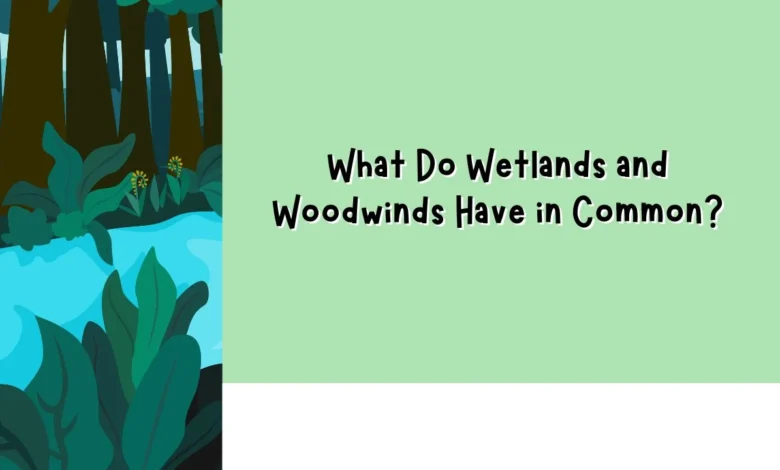What Do Wetlands and Woodwinds Have in Common?

When you think about wetlands and woodwinds, they might seem like two completely different things. Wetlands are natural areas filled with water, while woodwinds are a group of musical instruments. But if you look closely, you’ll find that there are some surprising similarities between the two. In this article, we’ll explore what wetlands and woodwinds have in common. We’ll discuss their importance, their roles in the environment and music, and how they both bring harmony to the world.
What Are Wetlands?
Wetlands are areas where water covers the soil, either all the time or just during certain seasons. They can be found in many places around the world and include swamps, marshes, and bogs. Wetlands are home to a wide variety of plants and animals, many of which are not found anywhere else.
These areas are very important because they help clean the water, provide a home for wildlife, and protect against flooding. Wetlands act like sponges, soaking up water and releasing it slowly, which helps to prevent floods. This ability to manage water is one thing that wetlands and woodwinds have in common, as we will see later.
What Are Woodwinds?
Woodwinds are a family of musical instruments that produce sound when a player blows air through them. The most common woodwinds include flutes, clarinets, oboes, and bassoons. Some woodwinds, like the flute, do not have reeds, while others, like the clarinet and oboe, use reeds to create sound. Woodwind instruments have been used for centuries to make music and are an important part of orchestras and bands. Just as wetlands play a crucial role in the environment, woodwinds are vital to the world of music. They both bring balance and beauty, whether in nature or in an orchestra.
What Do Wetlands and Woodwinds Have in Common: Support Life?
Wetlands are teeming with life. They provide food and shelter for many species of plants, birds, fish, and insects. Some animals, like frogs and turtles, depend on wetlands for their entire lives. Plants in wetlands are specially adapted to live in waterlogged conditions and are often unique to these areas. Similarly, woodwinds support the life of music.
They add rich tones and melodies that are essential to many types of music. Just as wetlands support the life cycles of various creatures, woodwinds support the structure and harmony of musical compositions. This shows another connection in what wetlands and woodwinds have in common: their ability to support life, whether in nature or in music.
What Do Wetlands and Woodwinds Have in Common: Create Harmony
Wetlands and woodwinds both contribute to harmony in their own ways. In nature, wetlands create harmony by balancing the water cycle, providing habitats, and cleaning the environment. They help maintain the ecosystem’s health, ensuring that plants and animals can thrive. Woodwinds create harmony in music by blending with other instruments to produce a balanced sound.
Each woodwind instrument has a unique voice, and when they play together, they create a rich, harmonious blend that enhances the overall musical experience. The harmony found in both wetlands and woodwinds shows how they bring different elements together to create something beautiful.
How Are Wetlands and Woodwinds Affected by Humans?
Human activities can have a big impact on both wetlands and woodwinds. Wetlands are often drained for agriculture, development, or other uses, which can destroy the habitats they provide. Pollution and climate change also threaten wetlands, making it harder for them to perform their important functions. Similarly, woodwinds can be affected by how they are made and played.
For example, deforestation can reduce the availability of the wood used to make these instruments. Additionally, the quality of sound from woodwinds can be affected by environmental factors like humidity and temperature. These challenges show what wetlands and woodwinds have in common: they both need to be protected and cared for so they can continue to enrich our world.
How Can We Protect Wetlands and Woodwinds?
Protecting wetlands and woodwinds is crucial for preserving the balance they bring to our environment and culture. For wetlands, this means conserving natural areas, reducing pollution, and supporting policies that protect these valuable ecosystems. Wetlands can be restored by planting native vegetation and removing invasive species that threaten the balance of the ecosystem.
Similarly, protecting woodwinds involves responsible sourcing of materials, such as using sustainably harvested wood. Musicians can also take care of their instruments by storing them properly and maintaining them regularly. By taking these steps, we can ensure that wetlands and woodwinds continue to provide their benefits for generations to come.
What Do Wetlands and Woodwinds Have in Common: Benefits
Wetlands and woodwinds offer many benefits that enrich our lives in different ways. Wetlands help control floods, filter water, and provide habitats for wildlife. They also offer recreational opportunities like birdwatching and fishing, which connect people with nature. Woodwinds bring joy through music, allowing people to express emotions and share cultural traditions.
They are also used in education, helping students develop skills in listening, coordination, and creativity. These benefits highlight what wetlands and woodwinds have in common: they both enhance our quality of life, whether through the environment or the arts.
| Benefits of Wetlands and Woodwinds | Wetlands | Woodwinds |
|---|---|---|
| Environmental Impact | Control floods and filter water | Made from natural materials |
| Habitat | Provide homes for many species | Essential in many musical genres |
| Cultural Significance | Offer recreational activities | Allow cultural expression through music |
| Educational Value | Teach about ecosystems and conservation | Teach music, coordination, and creativity |
How Do Wetlands and Woodwinds Inspire Creativity?
Wetlands and woodwinds both serve as sources of inspiration for creativity. Wetlands, with their rich biodiversity and tranquil landscapes, inspire artists, writers, and photographers. The unique ecosystems found in wetlands provide endless subjects for creative exploration. Woodwinds, on the other hand, inspire musicians and composers to create beautiful music.
The different sounds produced by woodwinds can evoke a wide range of emotions and ideas, leading to the creation of new and innovative musical pieces. This connection between wetlands and woodwinds shows how both can spark creativity in their respective fields, demonstrating yet another way in which they are alike.
What Can We Learn from Wetlands and Woodwinds?
Wetlands and woodwinds teach us important lessons about balance, harmony, and the need for protection. Wetlands show us the importance of maintaining balance in the environment, as they regulate water flow and provide essential services to the ecosystem.
Woodwinds teach us about harmony, as they blend with other instruments to create beautiful music. Both wetlands and woodwinds remind us of the delicate balance that must be maintained in nature and in culture. By understanding what wetlands and woodwinds have in common, we can appreciate their roles in our world and work to protect them for future generations.
Conclusion: What Do Wetlands and Woodwinds Have in Common?
What do wetlands and woodwinds have in common? While they may seem different at first glance, they share many similarities. Both contribute to the harmony of their environments, whether it’s the natural world or the world of music.
They support life, inspire creativity, and provide important benefits to humans and nature alike. By understanding these connections, we can better appreciate the roles that wetlands and woodwinds play in our world and the need to protect them. Whether in a marsh or a concert hall, wetlands and woodwinds remind us of the beauty and balance that are essential to life.




